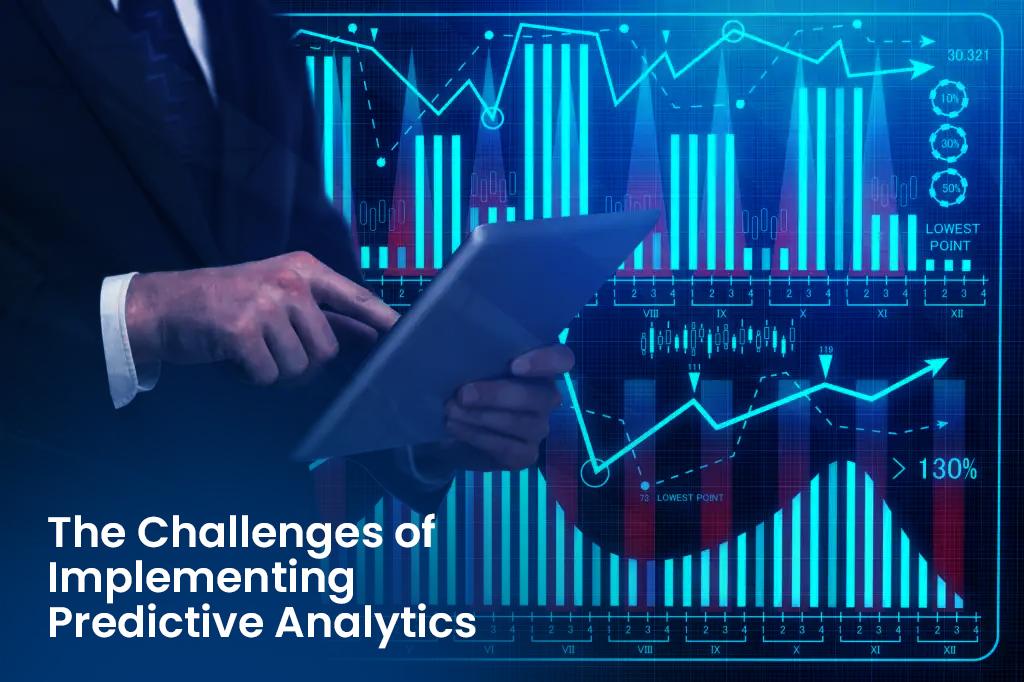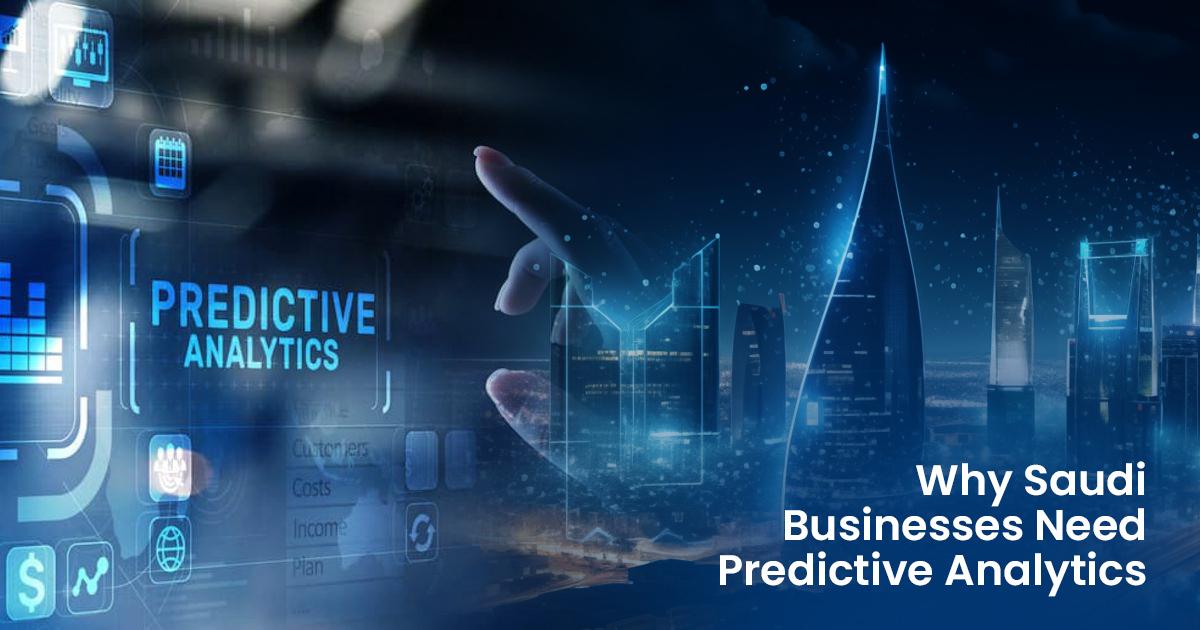Predictive Analytics in Saudi Arabia: A Must-Have for Modern Businesses
Predictive Analytics in Saudi Arabia is rapidly becoming a cornerstone of business strategy as the Kingdom accelerates its digital transformation under Vision 2030. In an era of rapid digital transformation, Saudi businesses face increasing pressure to adapt, innovate, and remain competitive. One of the most powerful tools driving this change is predictive analytics. This technology allows businesses to forecast future outcomes based on historical data, statistical algorithms, and machine learning models. As Saudi Arabia continues its push toward Vision 2030, which focuses on economic diversification and the enhancement of various key sectors, predictive analytics is rapidly becoming a must-have for businesses across the kingdom. Here’s why Saudi companies need to embrace predictive analytics now.
What is Predictive Analytics?
Predictive analytics uses data, statistical algorithms, and machine learning techniques to identify the likelihood of future outcomes based on historical data. By applying predictive models, businesses can anticipate market trends, consumer behavior, operational demands, and potential risks, enabling them to make informed, proactive decisions.
The Key Benefits of Predictive Analytics in Saudi Arabia
As Saudi Arabia strives toward achieving Vision 2030, predictive analytics is becoming an essential tool for businesses across all industries. With the ability to forecast future trends and outcomes, predictive analytics offers Saudi companies a competitive edge in the rapidly evolving marketplace. Here are the key benefits that predictive analytics brings to Saudi businesses:
1. Enhanced Decision-Making
Predictive analytics empowers business leaders to make data-driven decisions rather than relying on intuition. By analyzing historical data, predictive models can forecast trends and outcomes, allowing companies to anticipate market changes and make strategic decisions. These insights can help businesses align their strategies with emerging market demands, customer preferences, and industry developments.
For instance, in industries like retail, predictive analytics can guide inventory management, helping businesses avoid understocking or overstocking. Similarly, in finance, it can support investment decisions by forecasting market fluctuations and providing insights into potential risks.
2. Operational Efficiency
One of the most significant advantages of predictive analytics is its ability to optimize operations. By leveraging predictive models to forecast demand, businesses can enhance their supply chain management and streamline their processes. This ensures they are prepared for peak seasons or sudden changes in demand, thereby reducing costs and improving overall efficiency.
For example, in manufacturing, predictive maintenance can help predict equipment failures before they happen. This allows businesses to schedule maintenance proactively, preventing costly breakdowns and reducing downtime. By utilizing predictive analytics, businesses can enhance their operational performance, minimize waste, and maximize output.
3. Risk Mitigation
In today’s fast-paced business environment, uncertainty is a constant. Predictive analytics plays a crucial role in risk management by helping businesses identify potential threats before they become significant issues. Whether it’s financial volatility, supply chain disruptions, or market changes, predictive analytics can flag risks early, enabling companies to mitigate these risks proactively.
For instance, in the financial sector, predictive models can forecast changes in market conditions or customer behavior, helping businesses adjust their strategies in real-time. In sectors like energy or manufacturing, predictive analytics can help identify potential disruptions in the supply chain, allowing businesses to secure alternative solutions before they face operational losses.
4. Customer Insights and Personalization
Predictive analytics is invaluable in understanding consumer behavior and preferences. By analyzing past interactions, purchases, and browsing habits, businesses can personalize their marketing campaigns, product offerings, and customer experiences.
For example, in the retail and e-commerce sectors, predictive models can recommend products based on a customer’s previous shopping habits, increasing the likelihood of sales. By gaining deeper insights into customer needs, businesses can create more targeted marketing strategies, improve customer satisfaction, and build stronger brand loyalty.
5. Competitive Advantage
In Saudi Arabia’s dynamic and competitive market, businesses that adopt predictive analytics gain a significant competitive edge. By leveraging these tools, businesses can forecast trends before their competitors, allowing them to seize opportunities early and stay ahead of industry shifts. Whether it’s identifying a new market opportunity or predicting the next big trend, predictive analytics enables businesses to make proactive moves rather than reactive ones.
This competitive advantage is particularly crucial in industries like technology, retail, and finance, where staying ahead of market trends is essential to long-term success. By using predictive analytics, businesses can enhance market positioning, improve operational efficiencies, and deliver a superior customer experience, solidifying their place as industry leaders.
Key Sectors in Saudi Arabia That Can Benefit from Predictive Analytics

As Saudi Arabia continues to push towards its Vision 2030 goals, predictive analytics is playing a crucial role in transforming key sectors of the economy. By using data-driven insights to forecast future trends and outcomes, businesses across various industries can improve decision-making, optimize operations, and create value for both organizations and customers. Here’s how predictive analytics is benefiting key sectors in Saudi Arabia:
1. Healthcare
Predictive analytics in healthcare can revolutionize the way medical services are delivered, making systems more efficient and improving patient care. By analyzing historical health data, predictive models can help healthcare providers forecast patient needs, predict disease outbreaks, and optimize resource allocation.
- Forecasting Patient Needs: Hospitals and clinics can use predictive analytics to anticipate patient volumes, ensuring they are adequately staffed and equipped to meet demand, especially during peak times or potential health crises.
- Predicting Disease Outbreaks: By identifying patterns and trends in patient data, healthcare providers can predict the spread of diseases, allowing them to take preventive measures early.
- Optimizing Resource Allocation: Predictive analytics can help in forecasting the demand for medical resources, such as ICU beds, ventilators, and medications, ensuring they are available when needed.
- Improved Patient Outcomes: By analyzing treatment effectiveness and patient responses, predictive models can suggest personalized treatment plans, improving the quality of care and patient recovery rates.
2. Finance
The financial sector in Saudi Arabia is increasingly relying on predictive analytics to stay competitive and efficient. By leveraging data-driven models, financial institutions can better assess risks, detect fraud, and predict market trends.
- Fraud Detection: Predictive analytics helps banks and financial institutions identify unusual patterns in transaction data, enabling them to detect and prevent fraudulent activities in real-time.
- Credit Risk Assessment: By analyzing historical financial data, predictive models can evaluate the creditworthiness of individuals or businesses, helping financial institutions offer more accurate lending decisions and manage risks better.
- Market Trend Prediction: Predictive analytics can forecast market trends, interest rates, and investment opportunities, providing banks and investors with insights to make informed decisions.
- Personalized Financial Services: By predicting customer preferences and behavior, financial institutions can offer personalized financial products and services that better meet individual needs.
3. Retail and E-Commerce
In the retail and e-commerce sectors, predictive analytics can greatly enhance customer experience, streamline operations, and improve sales strategies. By understanding consumer behavior and predicting demand, retailers can optimize their offerings and ensure they meet customer expectations.
- Demand Forecasting: Retailers can predict demand for specific products based on seasonality, trends, and historical data, helping them optimize inventory levels and reduce costs associated with overstocking or understocking.
- Inventory Management: Predictive analytics allows businesses to ensure they have the right products in stock at the right time, minimizing supply chain disruptions and improving efficiency.
- Customer Personalization: By analyzing past customer purchases and preferences, predictive analytics enables businesses to offer personalized product recommendations and targeted marketing campaigns, which can increase customer loyalty and drive sales.
- Improved Customer Experience: Retailers can use predictive models to predict customer behavior, allowing them to proactively address potential issues and deliver a seamless shopping experience, both online and offline.
4. Manufacturing and Logistics
Manufacturing and logistics are two sectors that can significantly benefit from predictive analytics, particularly in optimizing production, reducing downtime, and improving supply chain management.
- Anticipating Equipment Failures: Predictive maintenance allows manufacturers to anticipate equipment breakdowns before they occur. By analyzing sensor data from machinery, businesses can predict when maintenance is needed, reducing unexpected downtime and repair costs.
- Optimizing Production Schedules: Predictive analytics can help manufacturers forecast demand, allowing them to adjust production schedules to meet market needs while avoiding overproduction or underproduction.
- Supply Chain Optimization: Predictive analytics can optimize inventory management, helping companies forecast the demand for raw materials and finished products, and streamlining procurement processes. This reduces costs associated with excess inventory and ensures smoother operations.
- Route Optimization in Logistics: In logistics, predictive analytics can optimize delivery routes, predict traffic patterns, and forecast delivery times, helping companies reduce transportation costs and improve delivery reliability.
- Demand Forecasting: Accurate demand forecasting enables both manufacturers and logistics providers to better plan and prepare for future needs, minimizing disruptions and ensuring timely product availability.
Building the Right Strategy to Implement Predictive Analytics

For Saudi businesses to fully leverage the power of predictive analytics, they need a well-defined strategy that ensures success across all stages of implementation. This strategy should be comprehensive, addressing data infrastructure, technology investments, workforce development, cross-functional collaboration, and continuous improvement. Here’s how businesses can build the right strategy:
1. Data Quality and Accessibility
The foundation of predictive analytics is high-quality, accessible data. Businesses must ensure that the data they use is accurate, complete, and structured for analysis.
- Data Infrastructure: Organizations need robust data storage and management systems, such as data lakes or cloud-based platforms, to store and process large volumes of data.
- Data Cleanliness: Ensuring that data is free from errors and inconsistencies is essential for building reliable predictive models.
- Data Accessibility: Data must be easily accessible to data scientists, analysts, and business teams to enable fast, data-driven decision-making.
2. Investment in the Right Tools and Technology
Predictive analytics relies on advanced tools and technologies, such as machine learning algorithms, AI platforms, and data analytics software. Saudi businesses must make strategic investments to ensure that they have the right tools for their specific needs.
- AI and Machine Learning Platforms: Businesses should choose platforms that offer scalable and customizable predictive analytics capabilities.
- Alignment with Business Goals: The technology chosen must align with the company’s long-term objectives and be flexible enough to adapt as the business evolves.
- Scalability: As businesses grow, they must ensure that the tools they invest in can scale to handle increasing amounts of data and more complex predictive models.
3. Skilled Workforce
A skilled workforce is crucial for the successful implementation and operation of predictive analytics. Saudi businesses must invest in talent or upskill their existing teams to ensure that they have the necessary capabilities.
- Training and Development: Businesses should prioritize training programs to upskill current employees in data science, machine learning, and predictive modeling.
- Hiring Experts: For businesses without the internal expertise, partnering with or hiring data science professionals can be a great way to kick-start predictive analytics initiatives.
4. Collaborating Across Teams
The implementation of predictive analytics requires collaboration between different departments, including IT, data science, and business leadership. This alignment ensures that predictive models support business goals and are seamlessly integrated into existing systems.
- Cross-functional Collaboration: Data scientists, IT professionals, and business leaders must work together to define objectives and identify the most valuable use cases for predictive analytics.
- System Integration: Collaboration between IT and business teams is also essential for integrating predictive analytics into existing processes and workflows.
5. Continuous Monitoring and Improvement
Predictive analytics models are not set-it-and-forget-it solutions. They require ongoing monitoring and refinement to ensure their accuracy and relevance.
- Model Refinement: As more data becomes available and market conditions evolve, predictive models should be continuously updated to reflect these changes.
- Performance Monitoring: Regular reviews should be conducted to evaluate how well predictive models are performing and whether they are meeting the business’s goals.
- Adaptation: Predictive models should be adjusted and fine-tuned based on feedback and real-world outcomes to improve their reliability over time.
The Challenges of Implementing Predictive Analytics

Despite the significant benefits of predictive analytics, businesses face several challenges when implementing this technology. Here are some of the key obstacles and how they can be addressed:
1. Data Privacy and Security
As predictive analytics requires large amounts of data, ensuring data privacy and security is a top concern for businesses.
- Regulatory Compliance: Businesses must comply with data protection regulations such as GDPR, CCPA, and Saudi Arabia’s own data privacy laws to protect customer information.
- Data Encryption: Sensitive data should be encrypted both in transit and at rest to prevent breaches and unauthorized access.
2. Integration with Legacy Systems
Many Saudi businesses operate with legacy infrastructure that may not be easily compatible with advanced predictive analytics tools.
- System Compatibility: Companies must plan carefully for the integration of predictive analytics into their existing systems to avoid disruptions. This could involve gradually transitioning to newer technologies or using APIs to bridge gaps between systems.
- Phased Approach: Implementing predictive analytics in phases allows businesses to test the integration and address any issues before full-scale deployment.
3. Skill Gap
The demand for skilled data scientists and analysts is high, and many businesses face difficulties in hiring or training staff with the necessary expertise.
- Upskilling Existing Employees: Companies can invest in training programs and certification courses to help existing employees build the necessary skills for predictive analytics.
- External Partnerships: For businesses without the in-house expertise, working with consultants or partnering with educational institutions can help fill the skill gap.
4. High Initial Investment
The cost of implementing predictive analytics can be substantial, particularly in terms of technology, tools, and training.
- Cost-Benefit Analysis: Businesses must evaluate the long-term benefits of predictive analytics, such as improved decision-making, cost savings, and increased revenue, to justify the upfront investment.
- Incremental Implementation: To reduce initial costs, businesses can implement predictive analytics gradually, starting with a few high-priority use cases and expanding over time.
Implementing predictive analytics is a transformative process that can deliver substantial benefits for businesses in Saudi Arabia. By investing in the right tools, developing a skilled workforce, ensuring data quality, and addressing integration challenges, businesses can harness the power of predictive analytics to drive innovation, enhance decision-making, and gain a competitive edge in a rapidly evolving market.
Conclusion: The Critical Role of Predictive Analytics in Saudi Businesses
Predictive analytics is no longer a luxury—it’s a necessity for Saudi businesses that aim to stay competitive in a fast-changing global marketplace. With its ability to provide data-driven insights, predictive analytics empowers businesses to make informed decisions, mitigate risks, optimize operations, and drive innovation. As Saudi Arabia continues to evolve towards a knowledge-based economy under Vision 2030, businesses that embrace predictive analytics will be better positioned to thrive in a data-driven world.
By leveraging predictive analytics, Saudi businesses can anticipate market trends, streamline their operations, and deliver personalized customer experiences, all of which are essential to driving economic diversification. Furthermore, predictive analytics enables businesses to take proactive measures, reducing risks associated with volatility and unforeseen disruptions.
As Saudi Arabia continues to invest heavily in technology, AI, and data science, businesses that integrate predictive analytics into their strategies will not only enhance their operational capabilities but also contribute to the broader goals of Vision 2030, positioning themselves as key players in the Kingdom’s journey towards sustainable, diversified growth.
In short, predictive analytics is more than just a tool—it’s a critical enabler of business success, economic growth, and long-term competitiveness in Saudi Arabia’s rapidly evolving market.


